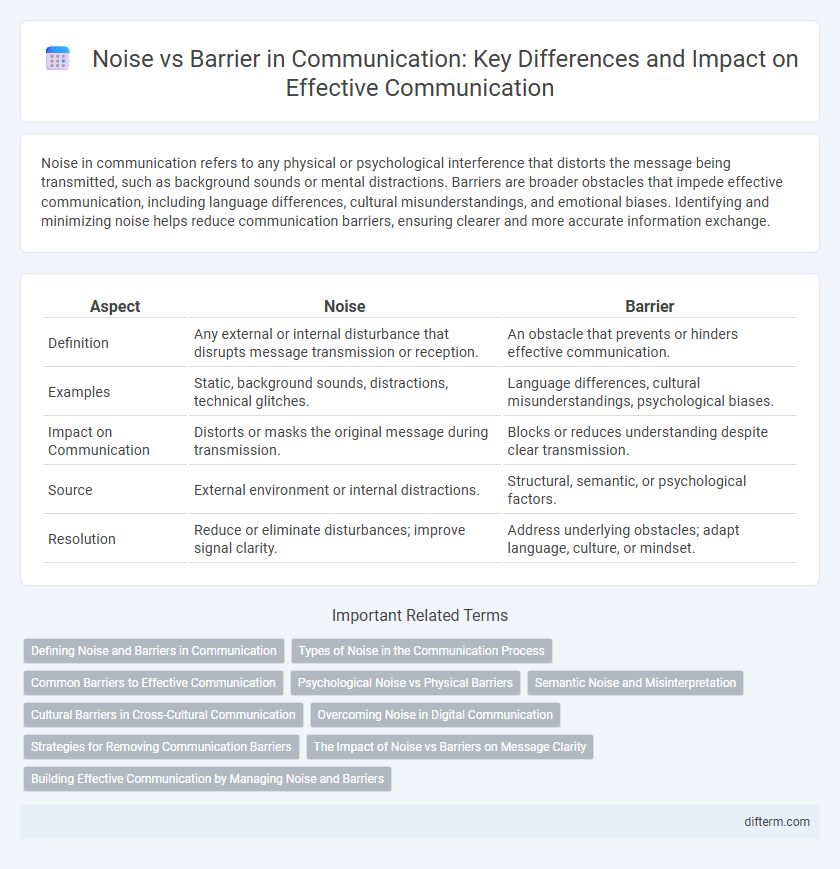Noise in communication refers to any physical or psychological interference that distorts the message being transmitted, such as background sounds or mental distractions. Barriers are broader obstacles that impede effective communication, including language differences, cultural misunderstandings, and emotional biases. Identifying and minimizing noise helps reduce communication barriers, ensuring clearer and more accurate information exchange.
Table of Comparison
| Aspect | Noise | Barrier |
|---|---|---|
| Definition | Any external or internal disturbance that disrupts message transmission or reception. | An obstacle that prevents or hinders effective communication. |
| Examples | Static, background sounds, distractions, technical glitches. | Language differences, cultural misunderstandings, psychological biases. |
| Impact on Communication | Distorts or masks the original message during transmission. | Blocks or reduces understanding despite clear transmission. |
| Source | External environment or internal distractions. | Structural, semantic, or psychological factors. |
| Resolution | Reduce or eliminate disturbances; improve signal clarity. | Address underlying obstacles; adapt language, culture, or mindset. |
Defining Noise and Barriers in Communication
Noise in communication refers to any physical or psychological interference that distorts or disrupts the transmission and reception of messages, such as background sounds, technical glitches, or emotional distractions. Barriers in communication encompass obstacles that hinder effective information exchange, including language differences, cultural misunderstandings, and organizational hierarchy constraints. Both noise and barriers contribute to miscommunication by affecting clarity, comprehension, and message accuracy in interpersonal, group, or mass communication settings.
Types of Noise in the Communication Process
Types of noise in the communication process include physical noise, such as background sounds that disrupt message reception, and psychological noise, which involves internal distractions like stress or preconceptions affecting interpretation. Semantic noise occurs when language or symbols are misunderstood due to different meanings or jargon, while physiological noise arises from biological factors like fatigue or hearing impairments that hinder effective communication. Identifying and managing these noise types is essential for enhancing clarity and reducing barriers in interpersonal and organizational communication.
Common Barriers to Effective Communication
Common barriers to effective communication include physical noise, such as background sounds that disrupt message clarity, and psychological noise, which involves mental distractions like stress or preconceived notions. Language differences and cultural misunderstandings also act as significant barriers by distorting the intended meaning. Overcoming these obstacles requires active listening and clear, concise messaging to ensure mutual understanding.
Psychological Noise vs Physical Barriers
Psychological noise in communication refers to internal mental distractions such as stress, biases, or emotional states that distort message interpretation, while physical barriers include external environmental factors like loud sounds, poor lighting, or technical issues that impede clear transmission. Psychological noise often affects message decoding by altering perception, whereas physical barriers hinder the actual delivery of information. Effective communication requires identifying and managing both psychological noise and physical barriers to ensure message clarity and understanding.
Semantic Noise and Misinterpretation
Semantic noise occurs when the sender and receiver assign different meanings to the same words or phrases, leading to communication breakdown. Misinterpretation arises from ambiguous language, cultural differences, or jargon that distort the intended message. Overcoming these barriers requires clarity, context, and shared understanding to ensure effective information exchange.
Cultural Barriers in Cross-Cultural Communication
Cultural barriers in cross-cultural communication refer to misunderstandings arising from differences in language, customs, values, and social norms that distort or block the intended message. These barriers act as noise, interfering with the accurate transmission and interpretation of information between individuals from diverse cultural backgrounds. Overcoming cultural barriers requires awareness, sensitivity, and adaptation to ensure effective and meaningful communication across cultures.
Overcoming Noise in Digital Communication
Overcoming noise in digital communication requires identifying and minimizing disruptions such as technical glitches, signal interference, and background sounds that distort message clarity. Utilizing advanced noise-cancellation technologies, clear audio protocols, and adaptive bandwidth management enhances the accuracy and effectiveness of information transfer. Prioritizing user-friendly interfaces and real-time feedback mechanisms further reduces misunderstandings caused by digital noise barriers.
Strategies for Removing Communication Barriers
Effective strategies for removing communication barriers include active listening, which ensures accurate message interpretation, and clarifying ambiguous information to prevent misunderstandings. Implementing feedback mechanisms allows for immediate correction of noise-induced distortions, while using clear, concise language minimizes semantic barriers. Cultural sensitivity training enhances interpersonal communication by addressing socio-cultural differences that often act as barriers.
The Impact of Noise vs Barriers on Message Clarity
Noise disrupts message clarity by introducing external or internal interference that distorts the receiver's understanding, such as background sounds or cognitive distractions. Barriers in communication, including language differences, cultural misunderstandings, or perceptual biases, obstruct effective message transmission by creating gaps in comprehension or acceptance. Both noise and barriers significantly reduce the accuracy and efficiency of communication, leading to misinterpretations and decreased information retention.
Building Effective Communication by Managing Noise and Barriers
Effective communication requires identifying and managing noise, which includes any sound or distraction that interferes with message transmission, and barriers such as language differences, cultural misunderstandings, or psychological factors that block clear understanding. Strategies like active listening, feedback loops, and simplifying language help reduce interference from noise and overcome communication barriers. Employing these methods enhances clarity and ensures the intended message is accurately received and interpreted.
noise vs barrier (in communication) Infographic

 difterm.com
difterm.com